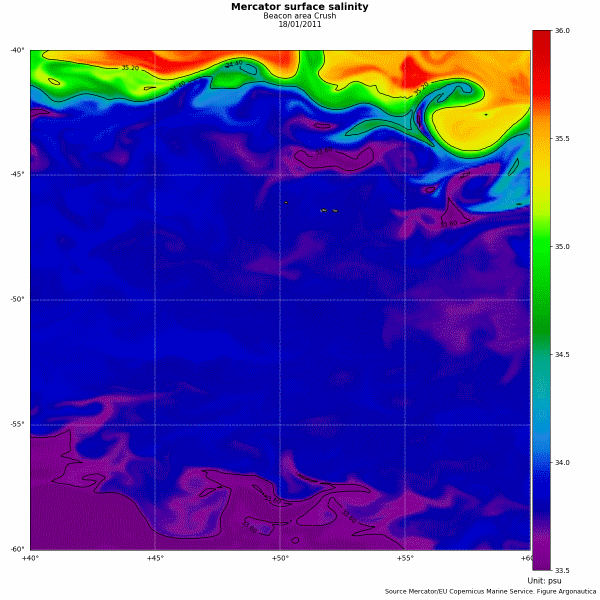Salinity
Salinity is the concentration of dissolved salts in sea water. Sodium chloride (ordinary table salt) is the most well known, but other mineral compounds can also be found. Salinity is a key parameter used to describe the oceanic processes since along with temperature and pressure; it influences the density of the sea water. These variations in density create, in particular, the thermohaline circulation, a major factor in the regulation of our climate.
Evaporation or the addition of fresh water (the melting of glaciers or sea ice) modifies salinity at the ocean's surface. Deeper in the ocean, the mixture of different waters causes variations in salinity (surface water sinking into the ocean depths due to its density, the arrival of deep Mediterranean water in the Atlantic, etc.).

Salinity map for 18/01/2011 over the "Crush" penguin zone. Salinity variations in this zone usually follow the same lines as the ocean's topography and the surface temperature. (Mercator/EU Copernicus Marine Service - Figure Argonautica)
Orders of magnitude
Salt is traditionally expressed in "psu" or "practical salinity unit". Actually, this is the weight of dissolved salt in grams per kilogram (hence, per litre) of water. In the ocean, it has a magnitude of 33 to 37 psu. It can reach 40 psu in the Mediterranean, particularly, in the East where evaporation is high and there is little addition of fresh water and smaller quantities of the Atlantic's less salty water.
Measurement techniques
Satellite measurements
The Smos satellite (Soil Moisture and Ocean Salinity, ESA) was launched in November 2009 to measure ocean salinity. It uses a microwave radiometer.
Smos measures "brightness temperature" at the surface, i.e. the energy emitted naturally by the surface at that frequency. We can determine salinity at the ocean's surface (SSS: Sea Surface Salinity) using this brightness temperature. This calculation is nevertheless fairly difficult because, on one hand, salinity has a fairly low effect on brightness temperature (0.5 K per psu at 20° C and only 0.3 K/psu at 5° C); and, on the other hand, brightness temperature does not depend on salinity alone: two other parameters, sea surface temperature (SST) and surface roughness (caused by initial approximations of "instantaneous" wind blowing in that place and time) play an important role.
Smos satellite data are not (yet) available in Argonautica.
Ocean measurements (in situ)
Ocean measurements are made by oceanographic ships during measurement campaigns, using drifting buoys deployed during scientific missions at sea, as for the Argo network, or anchored buoys such as TAO, PIRATA, etc.
Models
Oceanic forecast models also provide data on salinity. The Mercator model is used for salinity in Argonautica.

